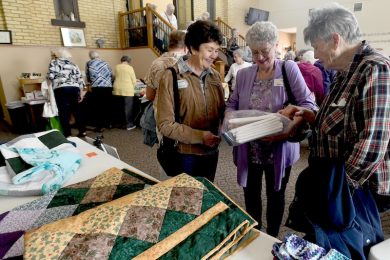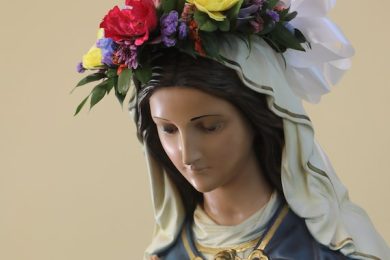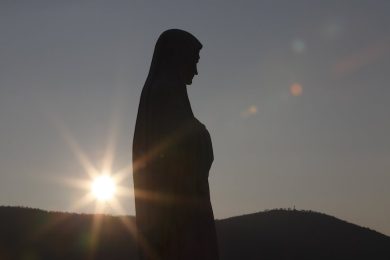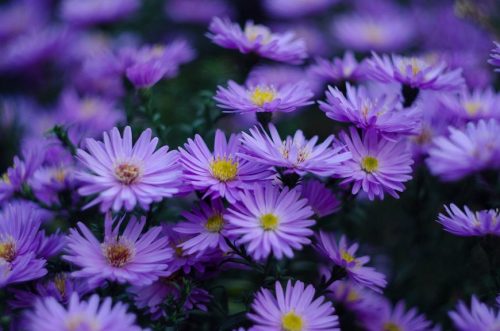
By Margaret Rose Realy | OSV News
“I am Raphael, one of the seven angels who stand and serve before the Glory of the Lord,” announced Raphael to Tobiah (Tb 12:15).
Our Blessed Mother is Our Lady of the Rosary and the Queen of Angels. October is devoted to the Holy Rosary and, less formally, the Holy Angels that guard and guide us on earth and into our eternity.
Angels are a significant part of God’s arsenal for us against evil. Not only can we petition the Archangels for help but we also each have our own personal guardians and all we need to do is be prayerfully mindful of their gentle but always attentive nudges.
There are seven archangels in our history; Roman Catholics name and honor three — St. Michael (God’s power), St. Gabriel (God’s voice) St. Raphael (God’s healing) — and recognize the other four whose names and spellings vary within traditions yet emphasize additional qualities of the Almighty — God’s light, beauty, righteousness and peace.
You can easily create a prayer garden dedicated to the archangels, whose feast day we celebrate on Sept. 29, or to your own guardian angel who we celebrate on Oct. 2.
The three archangels have their own symbolism and colors in Christian iconography:
St. Michael, hero of God, is often symbolized by a spear, and the colors gold, orange or red.
St. Gabriel, messenger of God, is depicted with lilies or a scroll, and his colors are often white, silver or blue.
St. Raphael, healer of God, is represented with a fish and the colors of green, yellow or gray.
Our gardens are beginning to wind down in most regions, but now is a good time to think about next year; why not plant flowers that represent the archangels? The Michaelmas daisy, “Aster novae-angliae,” flowers when daylight hours are shorter, usually near these feast days depending on which zone you live in. In the States, one of its common names is the New England Aster; it is a sturdy perennial running from pale pinks to saturated purples and growing 3’-5’ tall.
St. Michael is the hero and defender of God and as much as the iris and the gladiolus are both known as sword lilies both are appropriate symbols for this archangel. There are over 300 species of iris growing in a wide range of environments and hardiness zones, and just as many gladioli to choose from. The shield fern genus “Polystichum” — also called a “shield fern” — would also be appropriate in this garden.
For St. Gabriel, who sought Mary’s fiat at the Annunciation, plant the Madonna lily (“Lilium candidum”), or any white Asiatic or Oriental style trumpet lily. As Gabriel, our Blessed Mother shared the color blue in their symbolism, any flowers in this hue can be used.
St. Raphael is known as “God’s Healing” or “God’s Remedy.” The healing herb Garden Angelica, “Angelica archangelica,” is an appropriate plant though it grows quite large for a home garden. Its healing nature was revealed during the terrible Black Death of the Middle Ages. The legend goes that one of the archangels, probably Raphael, revealed the curative properties of this plant to a Benedictine monk who began using it in preparations to heal the sick. Better choices for the smaller garden are St. John’s Wort or any yellow flowering plants, or plants with silver leaves.
You could also create small shrines to add to your garden. Purchase unfinished birdhouses, disassemble them and discard the front and bottom. With the back panel, using outdoor paint (or seal acrylic paint with outdoor polyurethane) create an image of the angel with the tunic painted in its color; you could also decoupage a picture of the angel or archangel. Paint the other panels a solid color: light blue or soft yellow for the inside surfaces, brown or deep red on the outside. Reassemble the birdhouse (remember, no bottom or front) and attach it to tree trunks, fences, or posts in your garden, for a year-round shrine.
– – –
Margaret Rose Realy is a Benedictine Oblate and the author of “A Garden Catechism: 100 Plants in Christian Tradition and How to Grow Them” (OSV, 2022).






















